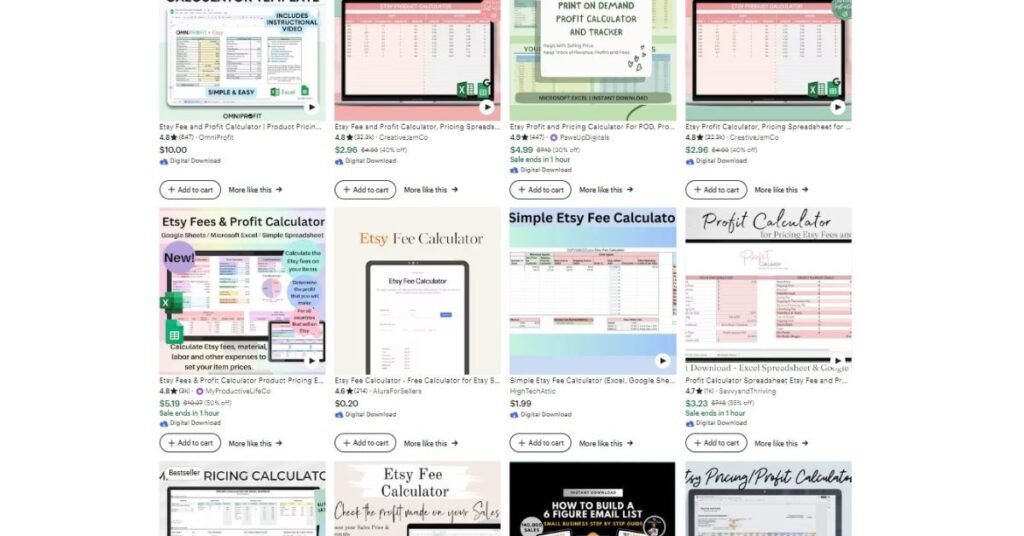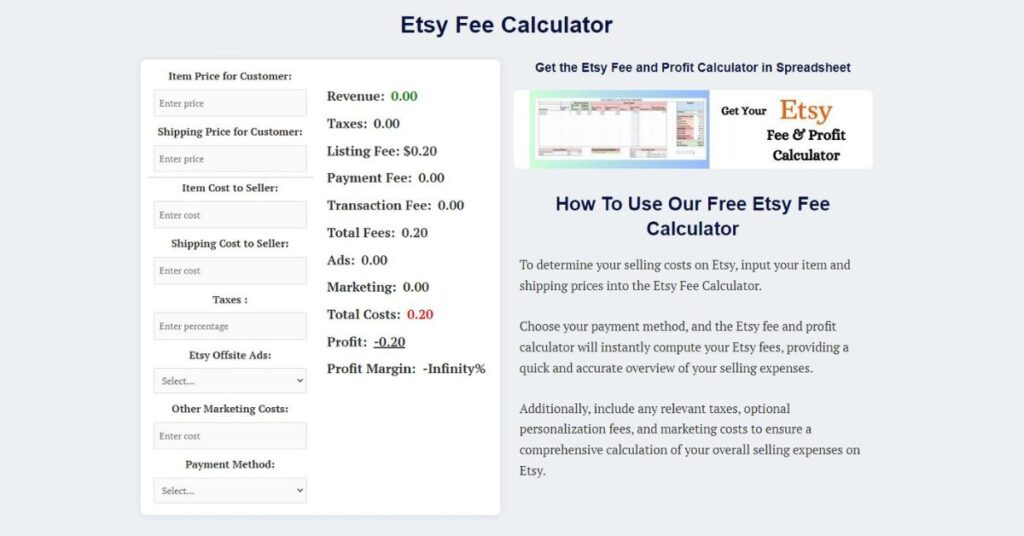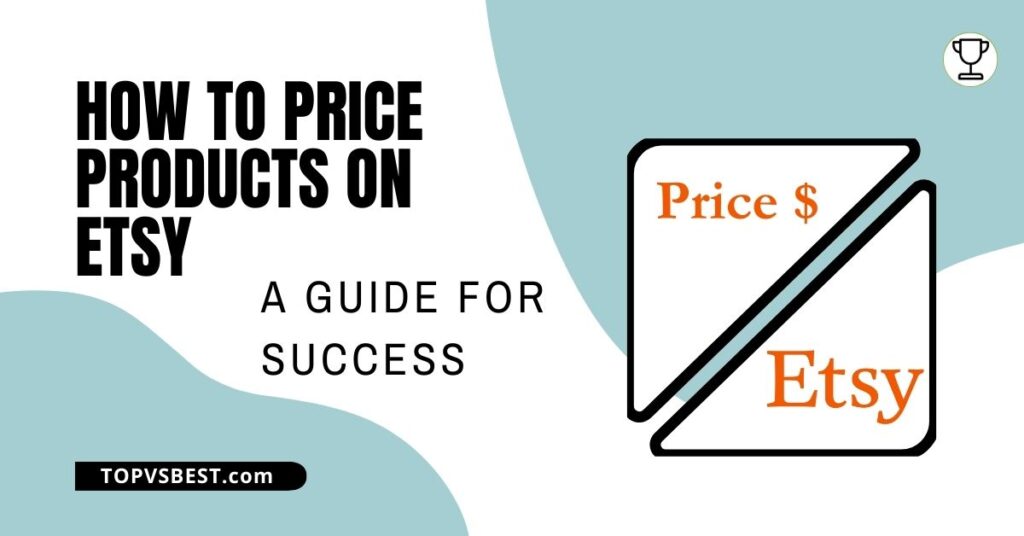Overview
Welcome to our guide on pricing Etsy products!
Getting your pricing strategy right is crucial for success if you want to sell on Etsy.
In this comprehensive guide, we’ll walk you through everything you need to know and explain how to price products on Etsy effectively to maximize profitability and attract customers.
Understanding The Importance Of Pricing
Pricing is more than just putting a number on your products; it’s a strategic decision that can make or break your business.
Set your prices too high, and you risk turning away potential customers. Set them too low, and you might not cover your costs or earn a profit.
Finding the sweet spot requires careful consideration of various factors, including your costs, market trends, and target audience preferences.
Researching The Market

Before you set your prices, it’s essential to research the market and understand what similar products are selling for on Etsy.
Tools like eRank or EverBee can help you analyze competitor pricing and identify market trends.
Pay attention to products of similar quality and features, as well as the pricing strategies used by successful sellers in your niche. (This is called Target Costing.)
Target Costing: Target costing involves setting prices based on competitive market prices. For example, if the average market price for a customized T-shirt is $30, you would aim to produce each jersey at a cost that allows for a target margin, such as 35% or 50%. This ensures that your product remains competitive within the market while still allowing for profitability.
Calculating Costs
To price your Etsy products effectively, you need to understand all the costs involved in producing and selling them. This includes materials, labor, overhead, and fees.
Use formulas like the wholesale price calculation ((Materials + Labor + Overhead) x 2) to ensure you cover your costs while still making a profit. (This is called Cost-Plus Pricing.)
Cost-Plus Pricing: Cost-plus pricing involves adding a percentage of profit to the cost of producing a product. For example, if the total cost to produce a print-on-demand T-shirt is $15 and you want to make a 50% profit, the selling price would be $30 ($15 cost + $15 profit).
Remember to factor in Etsy fees and taxes to determine your pricing accurately.
While cost-plus pricing is simple and ensures profitability, it does not consider competitor pricing or customer perception.
Target costing, however, allows you to set prices based on market conditions and competitive pressures, ensuring that your product remains competitive.
Psychological Pricing Strategies
Psychological pricing strategies can influence buyer perception and purchasing behavior.
Experiment with strategies like charm pricing (setting prices just below whole numbers – $29.99) and prestige pricing (setting higher prices to convey exclusivity and quality – $50).
These tactics can make your products more attractive to customers and help maximize sales.
Target Audience Considerations
Understanding your target audience is key to pricing your products effectively. Consider their preferences, budget, and purchasing habits when setting prices.
Tailor your pricing strategies to appeal to different customer segments, and be flexible in adjusting your prices based on market demand.
Testing And Experimentation
Pricing is not a one-size-fits-all approach. It requires ongoing testing and experimentation to find the optimal strategy for your Etsy shop.
Monitor sales data, customer feedback, and market trends to identify what works best for your products. Stay open to adjusting your prices based on the results of your experiments.
Maximizing Total Profit Through Pricing Strategies
To maximize total profit for Etsy products, it’s crucial to balance profit margin with sales volume.
This involves finding the optimal price point based on thorough market research, considering customer preferences, competitor pricing, and market demand.
Employing price discrimination strategies, offering volume discounts or bundle pricing, and implementing dynamic pricing can help achieve this balance.
By incentivizing larger purchases and adjusting prices in real-time, sellers can capture additional revenue while maintaining a reasonable profit margin, ultimately leading to maximum overall profitability.
Discounts, Bundles, And Free Shipping
Offering discounts, creating bundles, or providing free shipping can be effective strategies for attracting customers and increasing sales on Etsy.
However, sellers must carefully consider the impact of these promotions on their pricing structure and profit margins.
While discounts and free shipping can entice buyers, they also reduce the per-unit profit unless adequately factored into the overall pricing strategy.
Bundling products can be a smart way to encourage larger purchases while maintaining profitability.
Elevating Perceived Value
Enhancing the perceived value of your products can justify higher prices and differentiate you from competitors.
Use storytelling and branding to communicate the unique features and benefits of your products to customers.
Focus on providing an exceptional customer experience to build trust and loyalty with your audience.
Etsy Fees
When pricing products on Etsy, sellers need to account for various fees associated with the platform.
These include listing fees ($0.20), transaction fees (6.5%), and payment processing fees (3% + $025).
Understanding and factoring in these fees is crucial for setting competitive prices while ensuring profitability.
Sellers should calculate their expenses accurately to determine the pricing strategy that allows them to cover Etsy fees while still making a desirable profit.
Use Our Free Etsy Fee Calculator to accurately determine your Etsy fees:
Changing Marketplace
The Etsy marketplace is dynamic, with trends, demand, and competition constantly evolving.
Sellers must adapt their pricing strategies to remain competitive and meet the changing demands of buyers.
Monitoring market trends, analyzing competitors’ pricing, and staying responsive to customer feedback are essential practices for navigating the ever-changing landscape of the Etsy marketplace.
Flexibility and agility in pricing decisions are key to staying relevant and successful in this dynamic environment.
Importance Of Profit Margin
Maintaining a healthy profit margin is vital for the long-term sustainability and growth of a business on Etsy.
Sellers should prioritize setting prices that not only cover costs but also provide a reasonable profit margin.
A sufficient profit margin ensures sellers can reinvest in their business, cover operational expenses, and sustainably scale their operations over time.
A healthy profit margin also acts as a buffer against unexpected costs or market fluctuations, providing financial stability and resilience for Etsy sellers.
Pricing Strategies For Digital Products And Downloads
When it comes to pricing digital products and downloads on Etsy, sellers have a unique advantage compared to physical products.
While physical product sellers typically aim for at least a 30% profit margin after considering production costs, digital listings offer an opportunity for much higher profit margins.
This is because the costs associated with digital products primarily revolve around Etsy fees and the time invested in creating them, which sellers save if they produce the product themselves.
As a result, sellers can often afford to set higher prices for digital products while still maintaining attractive profit margins.
However, it’s essential to conduct market research and consider factors such as perceived value and competitor pricing when determining the optimal price for digital listings.
By leveraging this flexibility, sellers can maximize profitability in the digital product space on Etsy.
Example: Pricing A Spreadsheet Version Of An Etsy Fee Calculator

Our Etsy shop, HighTechAttic, offers a spreadsheet version of our Etsy Fee Calculator for sale.
This digital product is designed to help other Etsy sellers quickly and accurately calculate the fees associated with selling their products on the platform.
We priced this useful tool at $1.99.
By pricing the spreadsheet version of the Etsy Fee Calculator at $1.99, we aim to strike a balance between affordability and perceived value.
While the production costs for this digital product were minimal, mainly the time and effort invested in creating the spreadsheet, we recognize the value it provides to other Etsy sellers.
We hope to attract a larger customer base by offering it at a modest price while still generating a respectable profit margin.
Additionally, pricing the Etsy Fee Calculator at $1.99 makes it accessible to a wide range of Etsy sellers, including those who may be just starting and operating on a tight budget.
This affordability factor can serve as a competitive advantage, distinguishing our product from similar offerings on the market.
Conclusion
Pricing your Etsy products effectively is a critical aspect of running a successful online business.
By understanding your costs, researching the market, and experimenting with pricing strategies, you can find the right balance to maximize profitability and attract customers.
Remember to stay flexible and adapt your pricing strategy as needed to stay competitive in the ever-changing e-commerce landscape.



